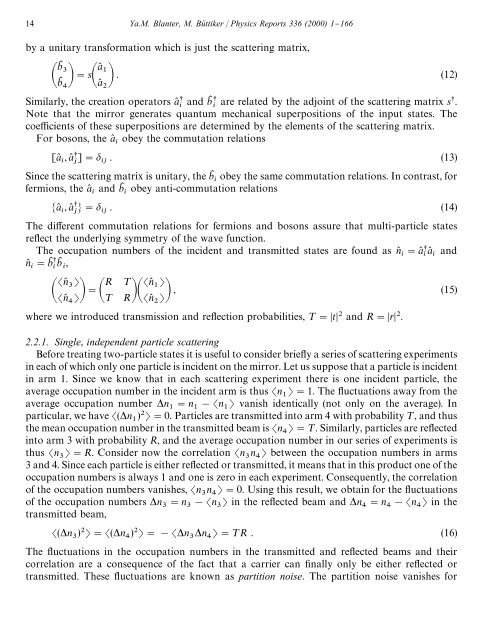shot noise in mesoscopic conductors - Low Temperature Laboratory
shot noise in mesoscopic conductors - Low Temperature Laboratory
shot noise in mesoscopic conductors - Low Temperature Laboratory
Create successful ePaper yourself
Turn your PDF publications into a flip-book with our unique Google optimized e-Paper software.
14 Ya.M. Blanter, M. Bu( ttiker / Physics Reports 336 (2000) 1}166<br />
by a unitary transformation which is just the scatter<strong>in</strong>g matrix,<br />
bK <br />
bK "s a( . (12)<br />
a( <br />
Similarly, the creation operators a( and bK are related by the adjo<strong>in</strong>t of the scatter<strong>in</strong>g matrix s.<br />
Note that the mirror generates quantum mechanical superpositions of the <strong>in</strong>put states. The<br />
coe$cients of these superpositions are determ<strong>in</strong>ed by the elements of the scatter<strong>in</strong>g matrix.<br />
For bosons, the a( obey the commutation relations<br />
[a( , a( ]" . (13)<br />
S<strong>in</strong>ce the scatter<strong>in</strong>g matrix is unitary, the bK obey the same commutation relations. In contrast, for<br />
fermions, the a( and bK obey anti-commutation relations<br />
a( , a( " . (14)<br />
The di!erent commutation relations for fermions and bosons assure that multi-particle states<br />
re#ect the underly<strong>in</strong>g symmetry of the wave function.<br />
The occupation numbers of the <strong>in</strong>cident and transmitted states are found as n( "a( a( and<br />
<br />
n( "bK bK ,<br />
<br />
n( <br />
n( " R ¹<br />
¹ R n( <br />
, (15)<br />
n( <br />
where we <strong>in</strong>troduced transmission and re#ection probabilities, ¹"t and R"r.<br />
2.2.1. S<strong>in</strong>gle, <strong>in</strong>dependent particle scatter<strong>in</strong>g<br />
Before treat<strong>in</strong>g two-particle states it is useful to consider brie#y a series of scatter<strong>in</strong>g experiments<br />
<strong>in</strong> each of which only one particle is <strong>in</strong>cident on the mirror. Let us suppose that a particle is <strong>in</strong>cident<br />
<strong>in</strong> arm 1. S<strong>in</strong>ce we know that <strong>in</strong> each scatter<strong>in</strong>g experiment there is one <strong>in</strong>cident particle, the<br />
average occupation number <strong>in</strong> the <strong>in</strong>cident arm is thus n "1. The #uctuations away from the<br />
average occupation number n "n !n vanish identically (not only on the average). In<br />
particular, we have (n )"0. Particles are transmitted <strong>in</strong>to arm 4 with probability ¹, and thus<br />
the mean occupation number <strong>in</strong> the transmitted beam is n "¹. Similarly, particles are re#ected<br />
<strong>in</strong>to arm 3 with probability R, and the average occupation number <strong>in</strong> our series of experiments is<br />
thus n "R. Consider now the correlation n n between the occupation numbers <strong>in</strong> arms<br />
3 and 4. S<strong>in</strong>ce each particle is either re#ected or transmitted, it means that <strong>in</strong> this product one of the<br />
occupation numbers is always 1 and one is zero <strong>in</strong> each experiment. Consequently, the correlation<br />
of the occupation numbers vanishes, n n "0. Us<strong>in</strong>g this result, we obta<strong>in</strong> for the #uctuations<br />
of the occupation numbers n "n !n <strong>in</strong> the re#ected beam and n "n !n <strong>in</strong> the<br />
transmitted beam,<br />
(n )"(n )"!n n "¹R . (16)<br />
The #uctuations <strong>in</strong> the occupation numbers <strong>in</strong> the transmitted and re#ected beams and their<br />
correlation are a consequence of the fact that a carrier can "nally only be either re#ected or<br />
transmitted. These #uctuations are known as partition <strong>noise</strong>. The partition <strong>noise</strong> vanishes for
















